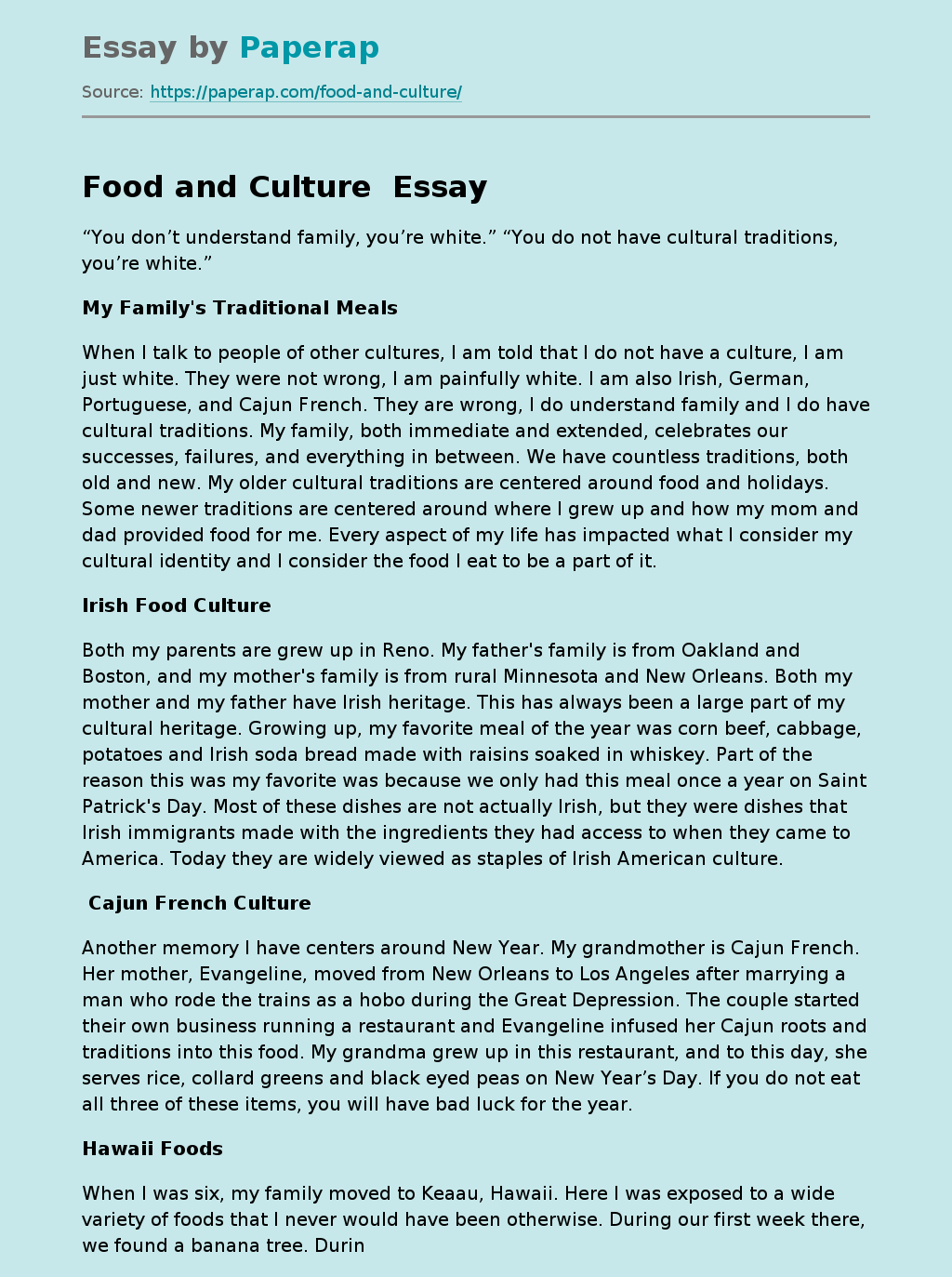Food and Culture
“You don’t understand family, you’re white.” “You do not have cultural traditions, you’re white.”
My Family’s Traditional Meals
When I talk to people of other cultures, I am told that I do not have a culture, I am just white. They were not wrong, I am painfully white. I am also Irish, German, Portuguese, and Cajun French. They are wrong, I do understand family and I do have cultural traditions. My family, both immediate and extended, celebrates our successes, failures, and everything in between.
We have countless traditions, both old and new. My older cultural traditions are centered around food and holidays. Some newer traditions are centered around where I grew up and how my mom and dad provided food for me. Every aspect of my life has impacted what I consider my cultural identity and I consider the food I eat to be a part of it.
Irish Food Culture
Both my parents are grew up in Reno.
My father’s family is from Oakland and Boston, and my mother’s family is from rural Minnesota and New Orleans. Both my mother and my father have Irish heritage. This has always been a large part of my cultural heritage. Growing up, my favorite meal of the year was corn beef, cabbage, potatoes and Irish soda bread made with raisins soaked in whiskey. Part of the reason this was my favorite was because we only had this meal once a year on Saint Patrick’s Day. Most of these dishes are not actually Irish, but they were dishes that Irish immigrants made with the ingredients they had access to when they came to America.
Today they are widely viewed as staples of Irish American culture.
Cajun French Culture
Another memory I have centers around New Year. My grandmother is Cajun French. Her mother, Evangeline, moved from New Orleans to Los Angeles after marrying a man who rode the trains as a hobo during the Great Depression. The couple started their own business running a restaurant and Evangeline infused her Cajun roots and traditions into this food. My grandma grew up in this restaurant, and to this day, she serves rice, collard greens and black eyed peas on New Year’s Day. If you do not eat all three of these items, you will have bad luck for the year.
Hawaii Foods
When I was six, my family moved to Keaau, Hawaii. Here I was exposed to a wide variety of foods that I never would have been otherwise. During our first week there, we found a banana tree. During the first month, I saw a pineapple growing out of its spiky bush. The other day I gave my friend papaya for the first time, and I remember my first time eating papaya, right after I picked one out of the back yard. My family’s favorite restaurant was the Japanese restaurant, where we had kimchi, miso soup, and tempura and for Sunday brunch we always ate sticky rice patties, papaya salad and summer rolls from the farmers market. Taro chips, poi, pork and hapia were common foods at parties. Fish, avocados and mangos are all major staples of food in ways that they are not here. Common fruits on the mainland, like watermelon, cucumber and oranges, are very uncommon in Hawaii.
My mom was always striving to provide healthy food. I grew up on organic, free range, food that was GMO free. We had a low gluten and dairy diet. I learned very early that just because a something in the store said natural it don’t mean it was healthy. We had salad for dinner every night in addition to a vegetable, carbohydrate and meat. Growing up, I was annoyed that I had to get up early for breakfast, or that being home for dinner was so important. I just wanted to buy the fun junk food in the stores, but we couldn’t because it had high fructose corn syrup in it. Looking back, I am grateful that we were financially stable enough to eat healthily. There are children everywhere who are not even getting enough calories, let alone the right amount of healthy calories. I am grateful that I was taught the importance of eating everything in moderation and habits like eating both breakfast and regularly throughout the day were ingrained in me.
My Cultural Identity
I consider all of my life a part of my cultural identity. My Irish and Cajun cultures, Hawaii and growing up with what I thought was a health nut of a mother. Another major part of what I consider when I think about my cultural identity and my relationship with food is my early childhood. As an infant, I suffered from failure to thrive. When I went in for my first checkup, I weighed significantly less than when I was born. I believe that this has impacted the way I value food. Sometimes I catch myself thinking that there isn’t enough, and that this might be the last time I eat.
I am grateful for my mom’s education in healthy eating, because I think that it helps to balance out my earliest interactions with food and hunger. I am grateful that I feel that I have a cultural identity and that I can pinpoint parts of my Irish and Cajun ancestry in the food that I eat around holidays. I am grateful for my metabolism, because I know that while it annoys me now, it probably helped my ancestors survive the potato famine. I am grateful for my childhood in Hawaii. It taught me to appreciate food in a whole new way. My favorite food to this day is papaya salad, sticky rice and summer rolls. I have tasted fruits that most people have never heard of, and I know that food is an integral part of a places culture.
Food and Culture . (2021, Nov 11). Retrieved from https://paperap.com/food-and-culture/

